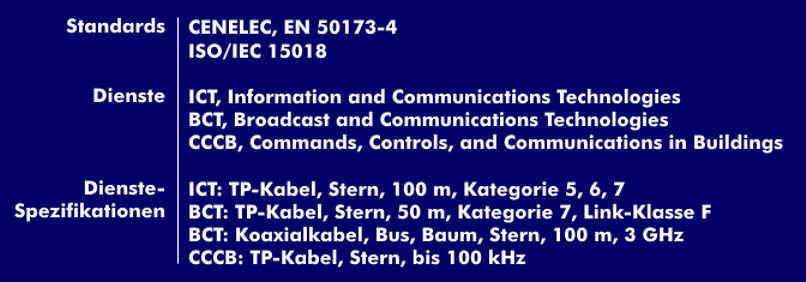home cabling
Home cabling is standardized by CENELECEN 50173-4 and ISO/IEC15018, which is based on the needs of its users. Conceptually, it takes into account the application scenarios of Information and Communications Technologies( ICT) for voice and data communications, Broadcast and Communications Technologies( BCT) for radio and television, and Commands, Controls, and Communications in Buildings( CCCB) for building automation.
Components of home networks
As with the cabling of offices and buildings, there are also cabling structures and corresponding components for home networks, such as the house transfer point(HÜP), the building distributors(GV) or apartment distributors(WV), and the junction boxes. Depending on the constellation, the house or apartment distributor forms the star point of the home cabling. From it, the services of all communication providers are distributed to the home network( HN) in tree or star topology.
The cabling designs for the various services are slightly different. For both Information and Communications Technologies (ICT) and Broadcast and Communications Technologies (BCT) services, the concept consists of a primary and secondary home cabling subsystem interconnected by a secondary residential distribution frame (SWV). Connection to the access network is made through the primary residential distribution frame (PWV).
The CCCB concept
The CCCB concept is different. There, the two subsystems are called Area Feeder Cabling and Coverage Area Cabling and are interconnected via the area connection( BAP). The primary and secondary residential distributors form the access point to the access network.
Different cables are also specified for the different services. For ICT services, TP cables of categories 5 to 100 MHz, 6 to 250 MHz and 7 to 600 MHz are used, which meet link classes D, E and F and distance requirements. Broadcast services (BCT), on the other hand, use coaxial cables for the frequency range up to 3 GHz and symmetrical category 7 cables. This means that the outlet sockets for data and broadcast services differ. While some have RJ45 sockets, others use the F connector or other coaxial plugs. Particularly simple, extremely stable and easy-to-mount plugs are used on FO connectors. Thus, the SMI connector, the SC-RJ connector and the EM-RJ connector are to be used, all SFF connectors in duplex design.
An interesting alternative to this concept is Fiber in the Home( FITH), with which FTTH is consistently continued in home networks in polymer fibers. These extend from the house transfer point to the optical outlet boxes(OAD) and have sufficient transmission capacity for all broadband services up to ultra HDTV.


-BCT-(Mitte)-und-CCCB_en.png)